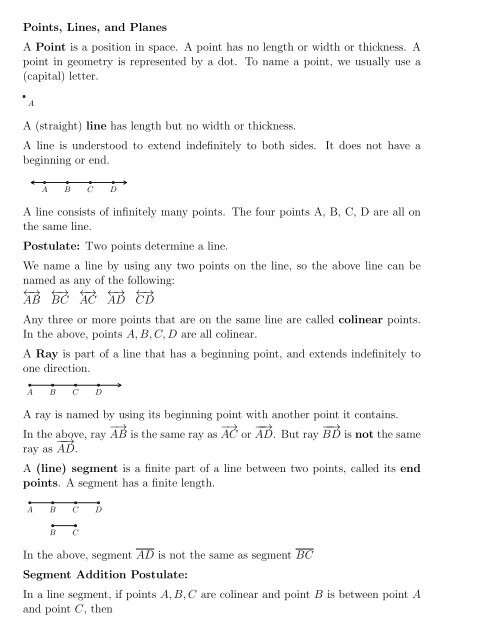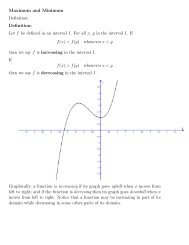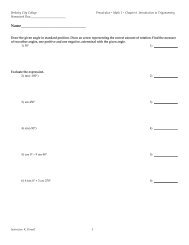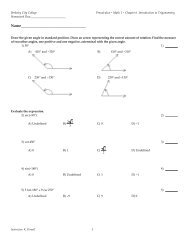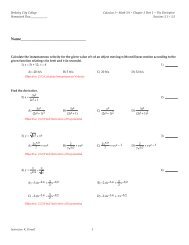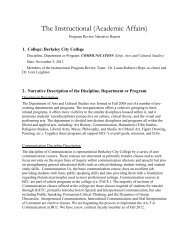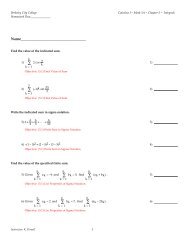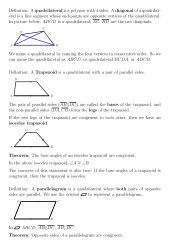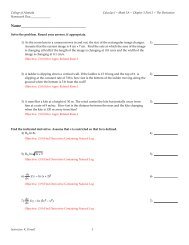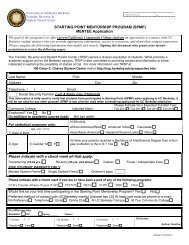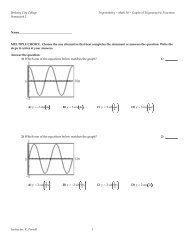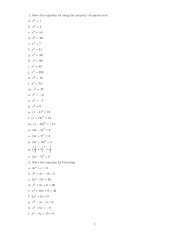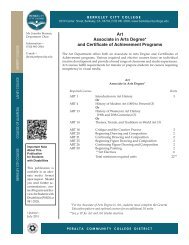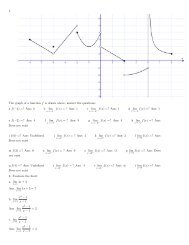Points, Lines, and Planes A Point is a position in space. A point has ...
Points, Lines, and Planes A Point is a position in space. A point has ...
Points, Lines, and Planes A Point is a position in space. A point has ...
You also want an ePaper? Increase the reach of your titles
YUMPU automatically turns print PDFs into web optimized ePapers that Google loves.
<strong><strong>Po<strong>in</strong>t</strong>s</strong>, <strong>L<strong>in</strong>es</strong>, <strong>and</strong> <strong>Planes</strong><br />
A <strong>Po<strong>in</strong>t</strong> <strong>is</strong> a <strong>position</strong> <strong>in</strong> <strong>space</strong>. A po<strong>in</strong>t <strong>has</strong> no length or width or thickness. A<br />
po<strong>in</strong>t <strong>in</strong> geometry <strong>is</strong> represented by a dot. To name a po<strong>in</strong>t, we usually use a<br />
(capital) letter.<br />
A<br />
A (straight) l<strong>in</strong>e <strong>has</strong> length but no width or thickness.<br />
A l<strong>in</strong>e <strong>is</strong> understood to extend <strong>in</strong>def<strong>in</strong>itely to both sides.<br />
beg<strong>in</strong>n<strong>in</strong>g or end.<br />
It does not have a<br />
A B C D<br />
A l<strong>in</strong>e cons<strong>is</strong>ts of <strong>in</strong>f<strong>in</strong>itely many po<strong>in</strong>ts. The four po<strong>in</strong>ts A, B, C, D are all on<br />
the same l<strong>in</strong>e.<br />
Postulate: Two po<strong>in</strong>ts determ<strong>in</strong>e a l<strong>in</strong>e.<br />
We name a l<strong>in</strong>e by us<strong>in</strong>g any two po<strong>in</strong>ts on the l<strong>in</strong>e, so the above l<strong>in</strong>e can be<br />
named as any of the follow<strong>in</strong>g:<br />
←→<br />
AB<br />
←→ BC<br />
←→ AC<br />
←→ AD<br />
←→ CD<br />
Any three or more po<strong>in</strong>ts that are on the same l<strong>in</strong>e are called col<strong>in</strong>ear po<strong>in</strong>ts.<br />
In the above, po<strong>in</strong>ts A, B, C, D are all col<strong>in</strong>ear.<br />
A Ray <strong>is</strong> part of a l<strong>in</strong>e that <strong>has</strong> a beg<strong>in</strong>n<strong>in</strong>g po<strong>in</strong>t, <strong>and</strong> extends <strong>in</strong>def<strong>in</strong>itely to<br />
one direction.<br />
A B C D<br />
A ray <strong>is</strong> named by us<strong>in</strong>g its beg<strong>in</strong>n<strong>in</strong>g po<strong>in</strong>t with another po<strong>in</strong>t it conta<strong>in</strong>s.<br />
In the above, ray −→ AB <strong>is</strong> the same ray as −→ AC or −→ −−→<br />
AD. But ray BD <strong>is</strong> not the same<br />
ray as −→ AD.<br />
A (l<strong>in</strong>e) segment <strong>is</strong> a f<strong>in</strong>ite part of a l<strong>in</strong>e between two po<strong>in</strong>ts, called its end<br />
po<strong>in</strong>ts. A segment <strong>has</strong> a f<strong>in</strong>ite length.<br />
A B C D<br />
B<br />
C<br />
In the above, segment AD <strong>is</strong> not the same as segment BC<br />
Segment Addition Postulate:<br />
In a l<strong>in</strong>e segment, if po<strong>in</strong>ts A, B, C are col<strong>in</strong>ear <strong>and</strong> po<strong>in</strong>t B <strong>is</strong> between po<strong>in</strong>t A<br />
<strong>and</strong> po<strong>in</strong>t C, then
AB + BC = AC<br />
You may look at the plus sign, +, as add<strong>in</strong>g the length of the segments as<br />
numbers. Or you may look at it as putt<strong>in</strong>g the two segments together. If two<br />
segments have the same length, we say that they are congruent to each other,<br />
<strong>and</strong> use the symbol, ∼ =, to denote. Pictorially, congruent segments (<strong>and</strong> other<br />
figures) can be put on top of each other (super-impose) <strong>and</strong> fit perfectly.<br />
If two different l<strong>in</strong>es <strong>in</strong>tersect, then their <strong>in</strong>tersection <strong>is</strong> a po<strong>in</strong>t, we call that po<strong>in</strong>t<br />
the po<strong>in</strong>t of <strong>in</strong>tersection of the two l<strong>in</strong>es.<br />
If AC <strong>is</strong> a l<strong>in</strong>e segment <strong>and</strong> M <strong>is</strong> a po<strong>in</strong>t on AC that makes AM ∼ = MC, then<br />
M <strong>is</strong> the midpo<strong>in</strong>t of AC. If there <strong>is</strong> another segment (or l<strong>in</strong>e) that conta<strong>in</strong>s<br />
po<strong>in</strong>t M, that l<strong>in</strong>e <strong>is</strong> a segment b<strong>is</strong>ector of AC.<br />
D<br />
A M C<br />
B<br />
In the above, segment AM ∼ = MC (notice that we use a tick-mark on each of<br />
the two segments to <strong>in</strong>dicate that the two segments are congruent to each other),<br />
so M <strong>is</strong> the mid-po<strong>in</strong>t of AC. S<strong>in</strong>ce BD <strong>is</strong> a l<strong>in</strong>e segment that conta<strong>in</strong>s the<br />
mid-po<strong>in</strong>t, M, of AC, so BC <strong>is</strong> a segment b<strong>is</strong>ector, or simply a b<strong>is</strong>ector of<br />
AC.<br />
The two l<strong>in</strong>e segments AC <strong>and</strong> BD <strong>in</strong>tersect at the po<strong>in</strong>t M, so M <strong>is</strong> the po<strong>in</strong>t<br />
of <strong>in</strong>tersection of the two segments.<br />
A surface <strong>has</strong> length <strong>and</strong> width, but no thickness.<br />
A plane surface, or simply a plane, <strong>is</strong> a surface where any straight l<strong>in</strong>e that<br />
conta<strong>in</strong>s two po<strong>in</strong>ts on the plane lies entirely on the plane. A plane extends<br />
<strong>in</strong>def<strong>in</strong>itely to all directions. (Th<strong>in</strong>k of a plane as a piece of flat paper that <strong>is</strong><br />
<strong>in</strong>f<strong>in</strong>itely large, have no thickness)<br />
Angles<br />
An angle <strong>is</strong> formed by two rays with a common end po<strong>in</strong>t. Each ray form a side<br />
of the angle <strong>and</strong> the commond end po<strong>in</strong>t <strong>is</strong> the vertex of the angle. The symbol<br />
for an angle <strong>is</strong> ∠<br />
An angle can be named by nam<strong>in</strong>g just the po<strong>in</strong>t of the vertex, if there <strong>is</strong> only<br />
one angle with that vertex.
An angle can also be named us<strong>in</strong>g three po<strong>in</strong>ts, where the middle po<strong>in</strong>t <strong>is</strong> the<br />
vertex <strong>and</strong> the first <strong>and</strong> last po<strong>in</strong>t <strong>is</strong> any po<strong>in</strong>t on each of the sides.<br />
We may also put a letter or number <strong>in</strong> the angle <strong>and</strong> name the angle with us<strong>in</strong>g<br />
the alphabet or number.<br />
C<br />
1<br />
A<br />
B<br />
The above angle can be named as just ∠C, or we can name it as ∠ACB or<br />
∠BCA. We can also name it as ∠1<br />
The size of an angle <strong>is</strong> determ<strong>in</strong>ed by how much one side of the angle must be<br />
rotated about the vertex to meet the other side of the angle. (Th<strong>in</strong>k of the size<br />
of an angle as how much the angle opens.)<br />
We may also assign numbers to the size of an angle. A commonly used measurement<br />
of size of angles <strong>is</strong> degrees. We use a little circle to represent an<br />
angle measurement <strong>in</strong> degrees. For example, ∠ACB <strong>is</strong> 33 degrees, <strong>and</strong> we write<br />
m∠ACB = 33 ◦ to denote th<strong>is</strong> fact.<br />
B<br />
C<br />
33 ◦<br />
A<br />
If two angles have the same size (same amount of open<strong>in</strong>g, same degree measure),<br />
we say that the two angles are congruent angles.<br />
B<br />
E<br />
C<br />
A<br />
F<br />
D<br />
In the picture above, ∠BCA ∼ = ∠EF D. Notice that we use a tick mark on the<br />
angles to <strong>in</strong>dicate that they are congruent. Geometrically, th<strong>is</strong> means that the<br />
two angles can be placed on top of each other <strong>and</strong> fit perfectly.<br />
Def<strong>in</strong>ition: Adjacent Angles are two angles that share a common side with <strong>and</strong><br />
have the same vertex.
D<br />
B<br />
C<br />
A<br />
In the above, ∠ACB <strong>and</strong> ∠BCD are adjacent angles, they share a common<br />
side CB <strong>and</strong> have the same vertex, C.<br />
Def<strong>in</strong>ition: Vertical Angles are two non-adjacent angles formed by two <strong>in</strong>tersect<strong>in</strong>g<br />
l<strong>in</strong>es. Vertical angles also share the same vertex.<br />
B<br />
E<br />
A<br />
C<br />
D<br />
In the picture above, segment AC <strong>in</strong>tersects BD at po<strong>in</strong>t E, so ∠AED <strong>and</strong><br />
∠BEC are vertical angles.<br />
∠BEA <strong>and</strong> ∠CED are also vertical angles.<br />
Angle Addition Postulate:<br />
The sum of the measure of two adjacent angles <strong>is</strong> equal to the measure of the<br />
angle formed by the non-common sides of the two adjacent angles.<br />
D<br />
B<br />
C<br />
A<br />
In the above, m∠ACB + m∠BCD = m∠ACD.<br />
Right Angles:<br />
If two l<strong>in</strong>es <strong>in</strong>tersect <strong>and</strong> make the two adjacent angles equal to each other, then<br />
each of the equal angle <strong>is</strong> a right angle. The two l<strong>in</strong>es that <strong>in</strong>tersect th<strong>is</strong> way <strong>is</strong><br />
said to be perpendicular to each other.
B<br />
C<br />
E<br />
A<br />
D<br />
In the picture above, CA <strong>in</strong>tersects BD at po<strong>in</strong>t E <strong>in</strong> such a way that makes<br />
∠CEB ∼ = ∠AEB. Therefore both ∠AEB <strong>and</strong> ∠CEB are both right angles.<br />
Notice that we use an angled mark<strong>in</strong>g to <strong>in</strong>dicate a right angle.<br />
S<strong>in</strong>ce they <strong>in</strong>tersect to form right angles, segments CA <strong>and</strong> BD are perpendicular<br />
to each other. We write CA ⊥ BD<br />
An acute angle <strong>is</strong> one which <strong>is</strong> less than a right angle.<br />
an obtuse angle <strong>is</strong> one that <strong>is</strong> greater than a right angle.<br />
E<br />
B<br />
D<br />
C<br />
A<br />
In the above, ∠ACD <strong>is</strong> acute, ∠ACB <strong>is</strong> right, <strong>and</strong> ∠ACE <strong>is</strong> obtuse.<br />
In degree measure, a right angle <strong>has</strong> a measurement of 90 ◦ . Notice that two<br />
adjacent right angles form a straight l<strong>in</strong>e. Therefore, a straight l<strong>in</strong>e (straight<br />
angle) <strong>has</strong> a measurement of 180 ◦<br />
Def<strong>in</strong>ition: Two angles are complementary if, when placed adjacent to each<br />
other with one side <strong>in</strong> common, their non-common sides form a right angle.<br />
Numerically, we say that two angles are complementary if the sum of their degree<br />
measurement equals 90 ◦<br />
In the above picture, ∠ACD <strong>and</strong> ∠DCB are complementary because they form<br />
a right angle.<br />
Example: A 35 ◦ angle <strong>is</strong> complementary to a 55 ◦ angle.<br />
Def<strong>in</strong>ition: Two angles are supplementary if, when placed adjacent to each<br />
other with one side <strong>in</strong> common, their non-common sides form a straight l<strong>in</strong>e.<br />
Numerically, we say that two angles are supplementary if the sum of their degree<br />
measure equals 180 ◦
D<br />
B<br />
C<br />
A<br />
In the above, ∠ACD <strong>and</strong> ∠BCD are supplementary. Their non-common sides<br />
form the straight l<strong>in</strong>e BA.<br />
Example: A 76 ◦ angle <strong>is</strong> supplementary to a 104 ◦ angle.<br />
Angle B<strong>is</strong>ector:<br />
If a l<strong>in</strong>e cuts an angle <strong>in</strong>to two equal smaller angles, the l<strong>in</strong>e <strong>is</strong> said to b<strong>is</strong>ect the<br />
angle <strong>and</strong> <strong>is</strong> an angle b<strong>is</strong>ector of the angle.<br />
D<br />
B<br />
C<br />
A<br />
In the picture above, ∠ACB ∼ = BCD, so CB <strong>is</strong> the angle b<strong>is</strong>ector of ∠ACD<br />
Just like with segments, we use tick-marks on the angles to <strong>in</strong>dicate that they<br />
are congruent to each other.<br />
When we look at two geometrical figures as be<strong>in</strong>g the same, there are two<br />
<strong>in</strong>terpretations.<br />
Geometrically, we say the geometrical objects are congruent, ∼ =. Th<strong>is</strong> means<br />
that the two geometrical objects have the exact same shape <strong>and</strong> form <strong>and</strong> can<br />
be placed on top of each other (super-imposted) perfectly.<br />
Algebraically, we can assign a numerical value to some of the aspects of a geometrical<br />
figure, such as the length of a l<strong>in</strong>e segment or a measurement to an<br />
angle. We can then <strong>in</strong>terpret two geometrical objects be<strong>in</strong>g equal to mean<br />
that they have the same numerical measurement. For example, we say that<br />
m∠ABC = m∠DEF to mean that the two angles have the same measurement<br />
(as numbers).<br />
Under all circumstances, if two geometrical figures are congruent geometrically<br />
then their character<strong>is</strong>tics will also be equal numerically, but you should underst<strong>and</strong><br />
that there <strong>is</strong> a difference between be<strong>in</strong>g congruent (geometrically) <strong>and</strong><br />
be<strong>in</strong>g equal (numerically).


